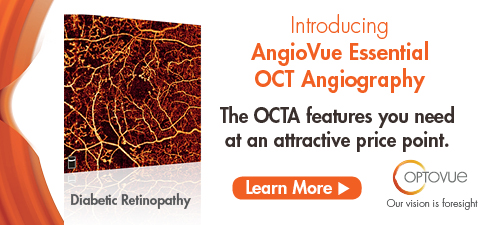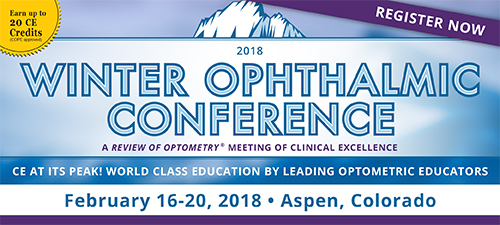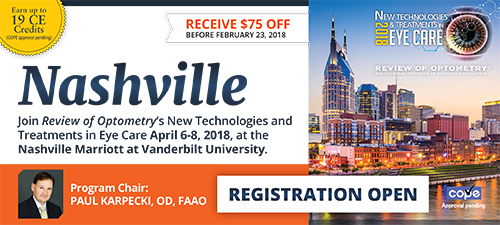
A
weekly e-journal by Art Epstein, OD, FAAO
Off the Cuff: Shifting Standards of Care
I hope everyone had a happy holiday. As I write this, it’s 75 degrees with the sun streaming through my office window here in Phoenix. I feel for those of you back East who are stuck in the throes of the bitter winter cold. Shannon and I had a taste of it during a brief holiday visit to her family in Nebraska. Kicking off our 2018 travels next week, we’ll be making our now annual pilgrimage to the Consumer Electronics Show in Las Vegas, where I expect to see more than a few innovations that will directly impact health care and health care providers.
|
|||||
|
|||
| Switching From BAK-Preserved to Preservative-free Latanoprost Decreases Anterior Chamber Flare in POAG Patients | ||||
To validate the hypothesis that BAK induces low-grade inflammation in the anterior chamber, researchers designed a study to investigate whether switching from BAK-preserved to preservative-free latanoprost in patients with primary open-angle glaucoma (POAG) would reduce the flare levels. Forty-one eyes of 22 patients with primary open-angle glaucoma treated with BAK-preserved latanoprost for at least six months as monotherapy were included. Exclusion criteria included any use of topical eye drops other than latanoprost, pseudoexfoliation and pigment dispersion glaucoma, wearing of contact lenses and intraocular surgery in the past year. At the start of the study, researchers measured baseline flare values. They then switched all patients to preservative-free latanoprost. After one, two and three months, a routine ophthalmological examination was performed and flare measurement repeated.
Thirty-three eyes were followed up throughout the entire three-month period. One month after the switch to preservative-free latanoprost, a statistically significant mean drop in flare of -0.96 ph/ms was observed. Mean flare decreased further by - 1.31 ph/ms after two months and by -1.25 ph/ms after three months. The switch from BAK-preserved to preservative-free latanoprost induced a statistically significant reduction in mean flare value. Whereas researchers’ previous study showed an increase in flare when initiating treatment with BAK-preserved eye drops, this study showed a decrease in flare upon cessation of BAK-preserved drugs. Researchers found that the combined evidence from the two studies strongly suggested that, in humans, BAK exerts its effects not only on the ocular surface, but also at the level of the anterior chamber. |
||||
SOURCE: Kestelyn PA, Kestelyn PG, De Bacquer D, et al. Switch from BAK-preserved to preservative-free latanoprost decreases anterior chamber flare in POAG patients. Int Ophthalmol. 2017; Dec 22. [Epub ahead of print]. |
||||
 |
||
Severe Corneal Ulcer with Progression to Endophthalmitis and High-grade Bacteremia |
||||
Bacterial sepsis is a common consequence of many infectious processes. Authors described a case of a woman with a corneal ulcer who went on to develop group B streptococcal (GBS) endophthalmitis, bacteremia and eventual loss of the eye.
A previously healthy, immunocompetent, middle-aged, contact lens-wearing female who, after freshwater boating in her contact lenses, developed a red, painful eye. She was initially prescribed an hourly topical steroid by an outside optometrist, but worsening of her condition prompted her to present to our the authors’ emergency department. Despite aggressive initial management, the patient went on to develop GBS endophthalmitis, sepsis with high-grade bacteremia and eventual loss of the eye. Authors wrote that eye care providers should exercise caution when prescribing frequent, potent corticosteroids when an infectious etiology is in the differential diagnosis. |
||||
SOURCE: Stryjewski TP, Chodosh J, Kim IK, et al. Severe corneal ulcer with progression to endophthalmitis and high-grade bacteremia. Am J Ophthalmol Case Rep. 2017;6:30-2. |
||||
|
|||
| A Novel Adaptive Deformable Model for Automated Optic Disc and Cup Segmentation to Aid Glaucoma Diagnosis | ||||
This paper proposed a novel Adaptive Region-based Edge Smoothing Model (ARESM) for automatic boundary detection of the optic disc and cup to aid in automatic glaucoma diagnosis. The novelty of the approach consisted of two aspects: automatic detection of initial optimum the object boundary based on a Region Classification Model (RCM) in a pixel-level multidimensional feature space, and an Adaptive Edge Smoothing Update model (AESU) of contour points (e.g., misclassified, irregular) based on iterative force field calculations with contours obtained from the RCM by minimizing energy function—an approach that does not require predefined geometric templates to guide auto-segmentation. Such an approach also provides robustness in capturing a range of variations and shapes, investigators wrote.
Investigators conducted a comprehensive comparison between their approach and state-of-the-art existing deformable models, and validated it with publicly available datasets. The experimental evaluation showed that the proposed approach significantly outperformed existing methods. Investigators suggested that the generality of the proposed approach would enable segmentation and detection of other object boundaries and provide added value in the field of medical image processing and analysis. |
||||
SOURCE: Haleem MS, Han L, Hemert JV, et al. A novel adaptive deformable model for automated optic disc and cup segmentation to aid glaucoma diagnosis. J Med Syst. 2017;42(1):20. |
||||
| News & Notes | ||||||||
| Aerie Gets FDA Nod for Rhopressa (netarsudil ophthalmic solution) 0.02% Aerie Pharmaceuticals announced that the U.S. Food and Drug Administration approved Rhopressa (netarsudil ophthalmic solution) 0.02% for the lowering of elevated intraocular pressure in individuals with open-angle glaucoma or ocular hypertension. The FDA approval decision was made two months ahead of the scheduled Prescription Drug User Fee Act goal date of Feb. 28. Rhopressa (netarsudil ophthalmic solution) 0.02% is a novel, once-daily eye drop believed to reduce IOP by increasing the outflow of aqueous humor through the trabecular meshwork. Read more. |
||||||||
Visiometrics Releases Software Update for HD Analyzer
|
||||||||
| WCO & Academy to Host Joint Education Meeting in 2019 The World Council of Optometry and the American Academy of Optometry will co-host the 3rd World Congress of Optometry in conjunction with the Academy meeting in Orlando, Fla., at the Orange County Convention Center. The meeting, tentatively set for Oct. 23-28, 2019, will feature joint CE tracks. Information on the meeting will be available in the future. Stay tuned.
|
||||||||
| B+L Receives 510(K) Approval for Crystalsert 2.6 Injector for Crystalens AO & Trulign Toric IOLs Bausch + Lomb announced that it received 510(k) clearance from the U.S. Food and Drug Administration for the Crystalsert 2.6 injector (CI-26). Designed for use across the entire diopter range of Crystalens AO and Trulign toric intraocular lenses, the CI-26 facilitates smooth delivery through an incision as small as 2.6 mm. The CI-26 features a smooth, oval tip shape to aid in wound entry and help prevent tissue snagging. The tip also has a straight delivery channel to reach the capsular bag without wound stretch. A haptic guide and modified plunger tip support the leading and trailing haptics during delivery. Read more.
|
||||||||
|
||||||||
|
||||||||
|
||||||||
|
Optometric Physician™ (OP) newsletter is owned and published by Dr. Arthur Epstein. It is distributed by the Review Group, a Division of Jobson Medical Information LLC (JMI), 11 Campus Boulevard, Newtown Square, PA 19073. HOW TO ADVERTISE |





